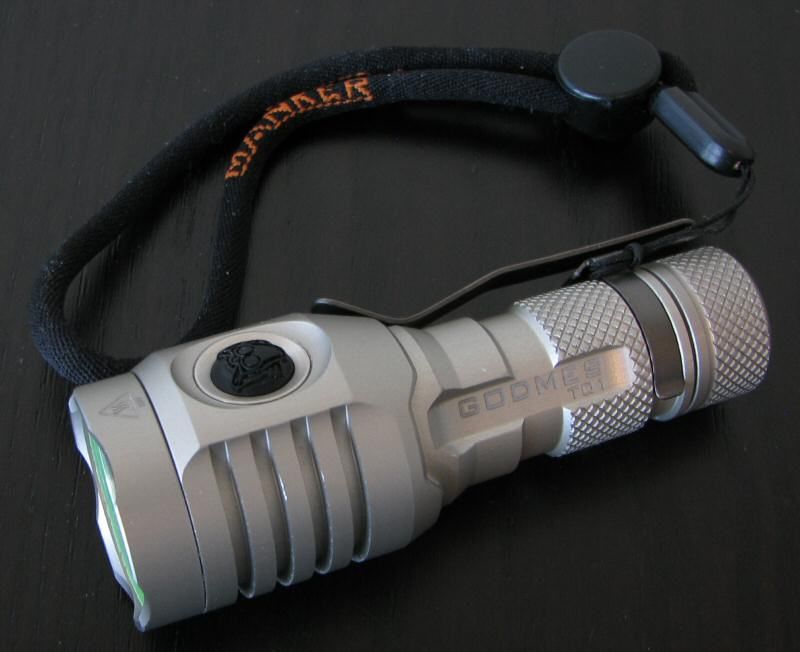
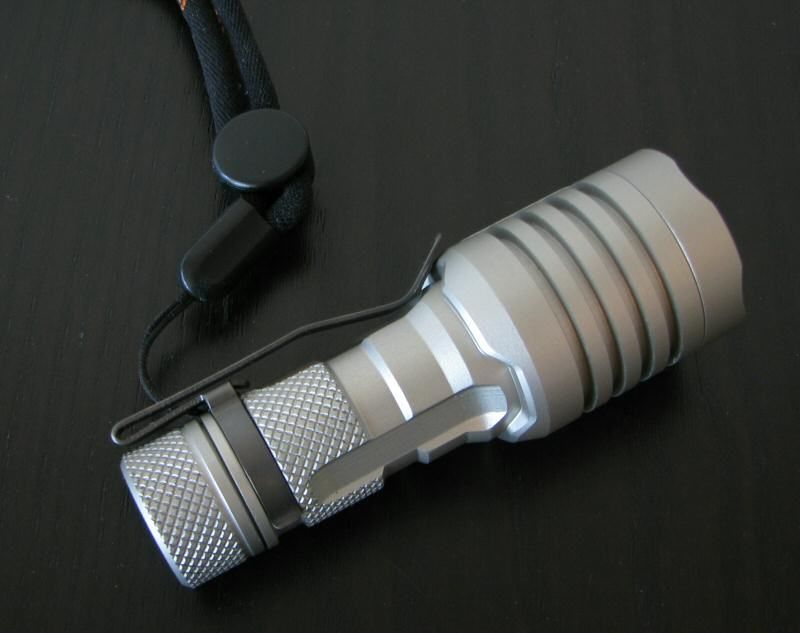
Manker is a relatively new manufacturer on the scene. Here I have the shipping version of their popular 1xAA light, the Quinlan T01. Using the latest Cree XP-L HI emitter (optimized for throw), the T01 has impressive specs on both standard AA and 14500. Let's see if it lives up to them. :wave:
Manufacturer Reported Specifications:
(note: as always, these are simply what the manufacturer provides – scroll down to see my actual testing results).
- CREE XPL-HI LED.
- Max Lumen Output: 500LM (drive byEneloop Pro NI-MH battery).
- Max Lumen Output: 900LM (drive by Lithium Battery 14500).
- Peak beam intensity: 10,000 cd (drive by Eneloop Pro NI-MH battery).
- Peak beam intensity: 20,000 cd (drive by Lithium Battery 14500).
- Beam distance: 925ft/ 282m.
- 4 brightness levels plus 3 modes: Turbo - high - mid - low - strobe - SOS - Location Beacon
- IPX-8 waterproof standard of up to 2 meters/6.6 feet. Protects the light from strong water drop and heavy rain
- Impact resist up to 2 meters/6.6 feet.
- Offers General and Pro two operating modes: Long press for 10s to change modes
- Compatible with Ni-MH AA, Li-ion 14500 and LiFeCOPO4 batteries: Easy to find and replace with
- Max 150 hours run time, suitable for outdoor and emergency use
- HA-III military standard hard anodized, original color.
- Tail stand
- Titanium coated two-way clip
- Machine from aerospace grade solid aluminum bar
- Size:Length 84mm Head Diameter 29MM Tail Diameter 20mm
- MSRP: ~$63
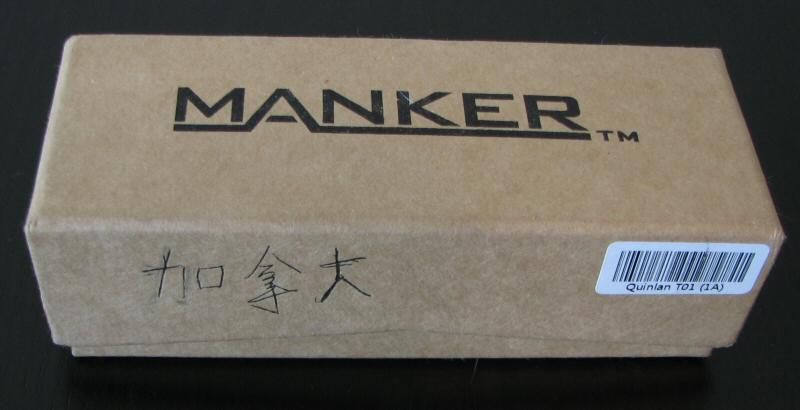
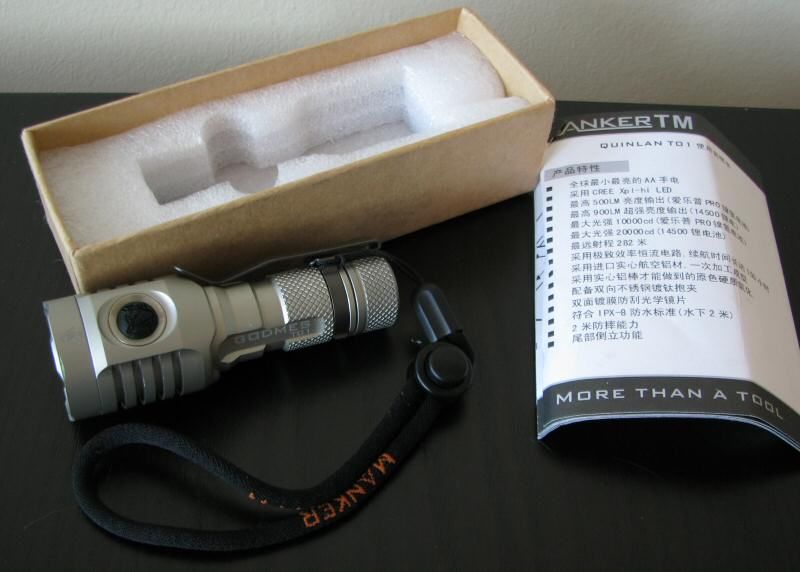
My T01 review sample came in simple hard cardboard box with cut-out packing foam. Included with the light were a pocket clip and simple wrist lanyard (both attached) and manual.
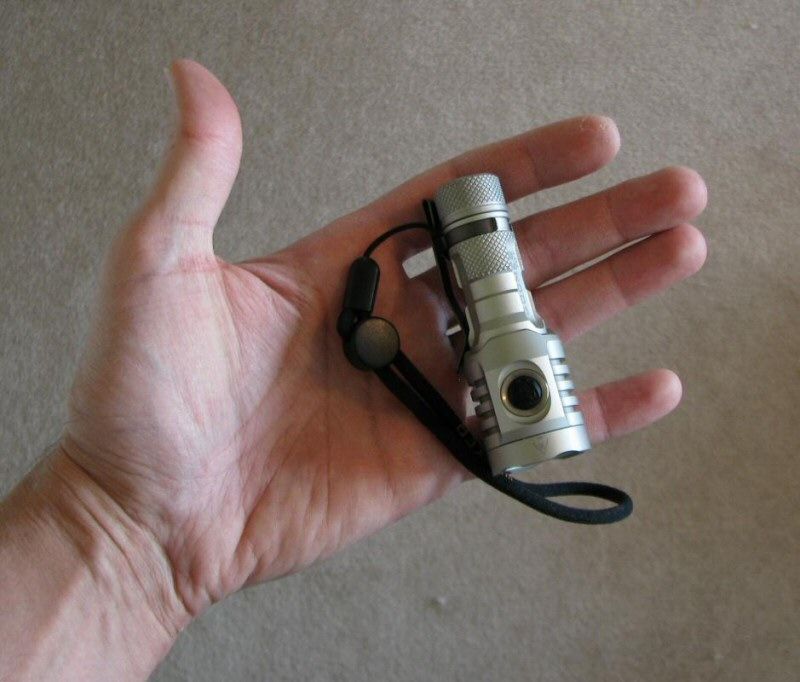
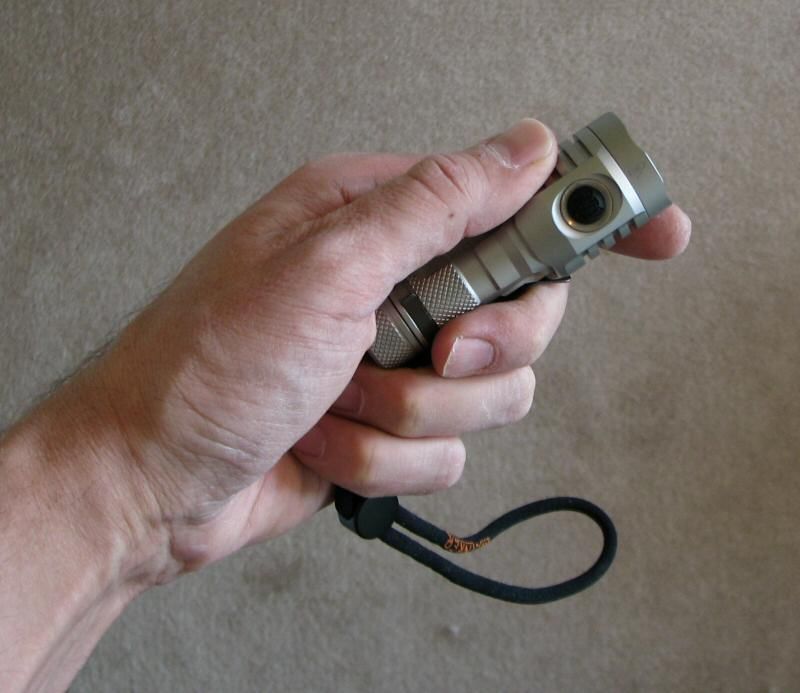
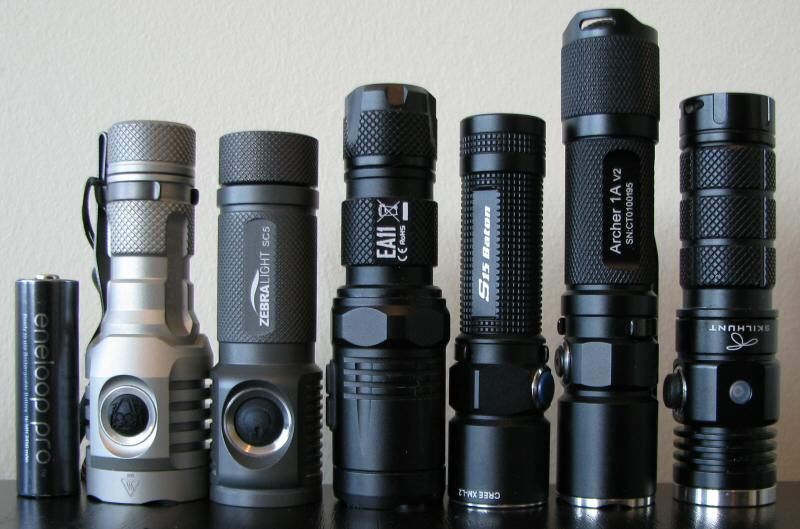
From left to right: Panasonic Eneloop Pro AA NiMH; Manker Quinlan T01; Zebralight SC5; Nitecore EA11; Olight S15; Thrunite Archer 1A V2; Skillhunt DS10.
All dimensions are given with no batteries installed:
Manker Quinlan T01: Weight: 61.7g, Length 84.5mm, Width (bezel) 29.8mm
Fenix LD12: Weight: 52.3g, Length: 99.9mm, Width (bezel): 21.6mm
Nitecore MT1A: Weight: 54.6g, Length: 104.6mm, Width (bezel): 22.7mm
Olight S15: Weight: 46.4g, Length: 87.0mm, Width (bezel): 23.1mm
L3 Illumination L10: Weight: 20.7g, Length: 79.4mm, Width (bezel): 17.1mm
Lumintop ED15: Weight: 59.7g, Length: 100.2, Width (bezel): 21.9mm
Skilhunt DS15: Weight: 52.0g, Length: 92.1mm, Width (bezel): 24.0mm
Thrunite Archer 1A v2 CW: Weight: 66.9g, Length: 109.6mm, Width: 23.1mm
Thrunite Neutron 2A 2014 (1xAA form): Weight: 57.6g, Length: 95.6mm, Width (bezel): 25.6mm
Zebralight SC5: Weight 58.3g, Length 81.5mm, Width (bezel): 22.6mm, Width (max) 27.0mm
Zebralight SC52: Weight 39.5g, Length 79.0mm, Width (bezel): 22.6mm, Width (max) 25.4mm
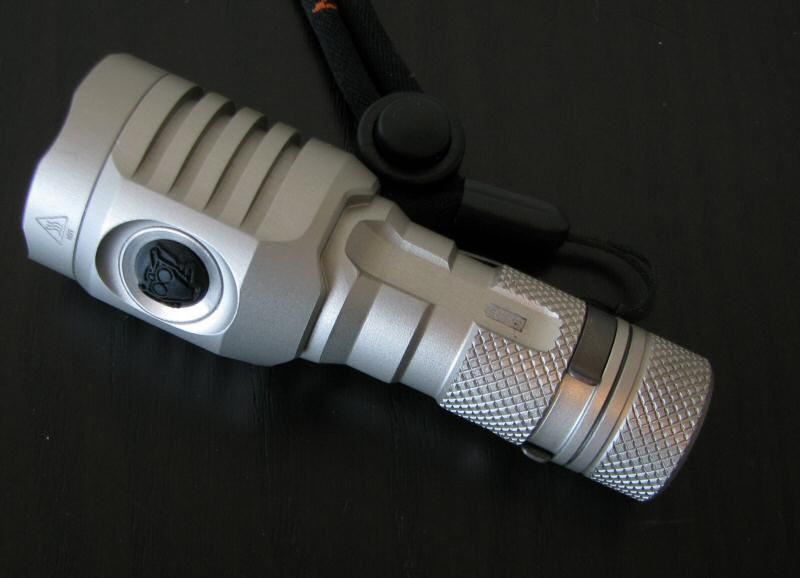
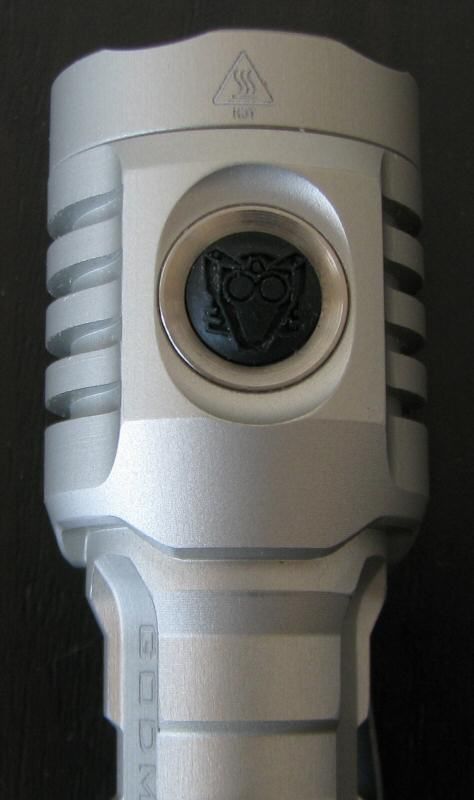
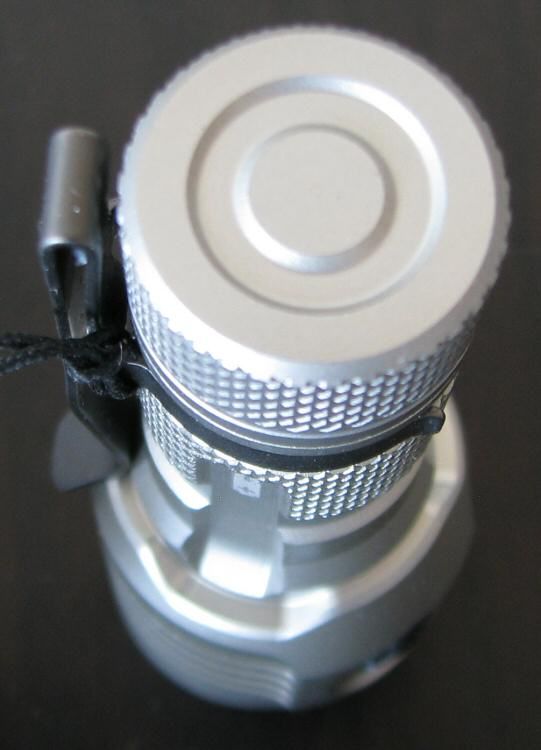
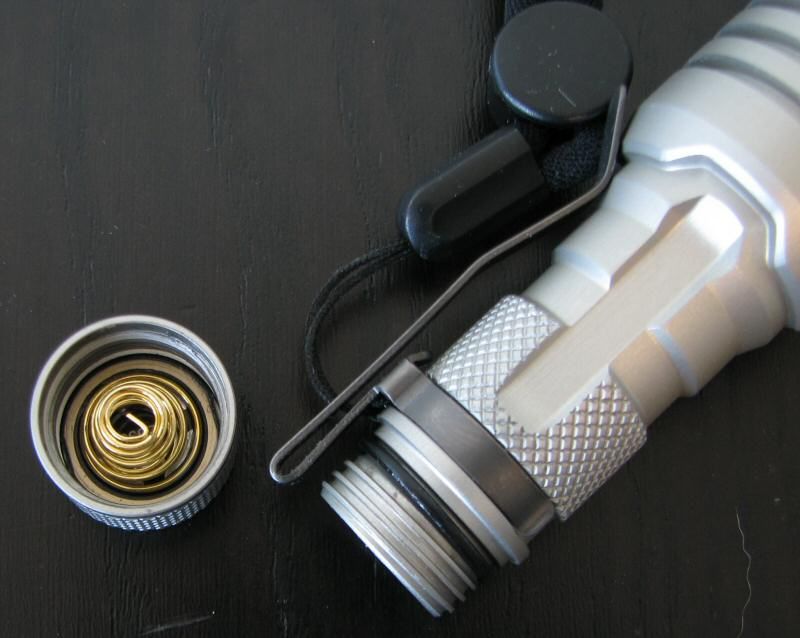
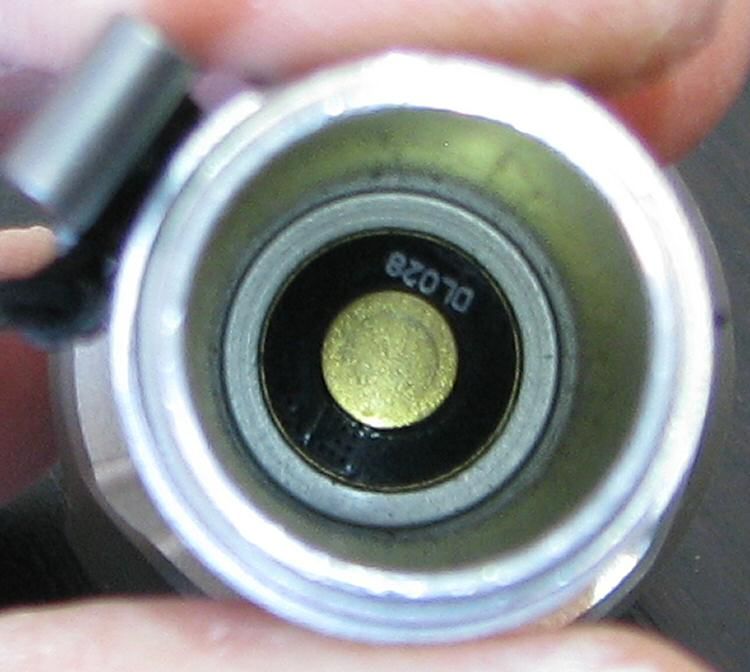
The overall build of the T01 seems to be of above average quality. Machining looks good, although the knurling and ridge detail is very smooth. There was no damage or chips on the light gray "natural" finish on my sample.
Switch is an electronic switch mounted on the head, slightly recessed, with a relatively grippy textured button cover. Switch feel is fairly typical for an electronic switch, and is easy to find by touch alone.
Screw threads are square-cut and anodized for tailcap lock out. There is a dual-spring design in the tailcap. The lighter secondary spring is presumably to provide a lower resistance path, which will be helpful on the high-current draw modes on 14500.
Note that the body tube is also a little short, and won't easily take protected 14500 batteries without a lot of force when screwing down the tailcap (and even then, may not connect). I was not able to use anything other than my AW protected 750mAh 14500s. The light may be best suited to unprotected 14500 (e.g. IMR). Also, flat-top 14500 batteries will not work in the light, due to the raised metal ring around the contact disc in the head.
The light comes with a removable metal pocket clip, and a reasonable wrist strap (that can only attach to the clip, as there is no attachment point on the body). Clip fits the body fairly firmly.
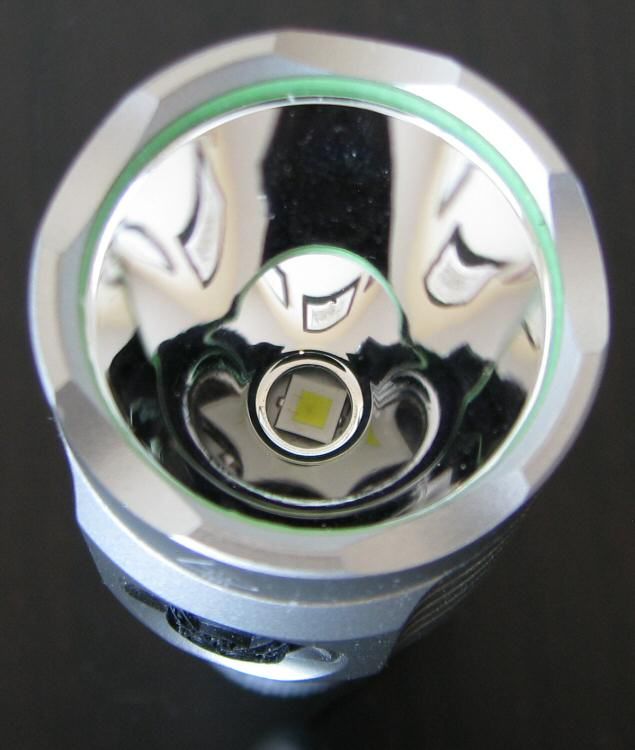
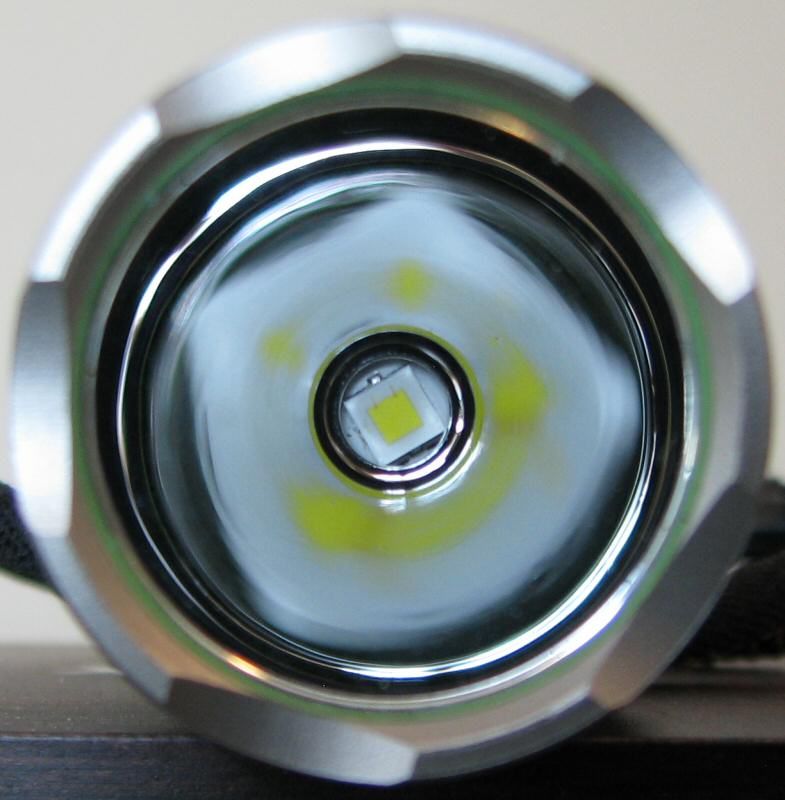
The head is relatively large for a 1xAA light, with a deep and smooth reflector for maximum throw. There is a luminescent green o-ring in the head, between the glass lens and bezel. Centering of the emitter seems pretty good – scroll down for beamshots and direct measures.
User Interface
The T01 has two control interfaces – a General Mode and a Pro mode.
General Mode
General mode is fairly straightforward. Press and hold the electronic switch to activate the light in its last memorized level (press and hold again to turn Off).
Single click to advance modes when on, in the reoccurring sequence of Lo > Med > Hi > Turbo.
There is a shortcut to the Lo mode from Off: simply click the switch (press and hold to turn off).
Double-click the switch when On to enter into the blinking modes. When in the blinking mode set, single click to advance through the following modes, in a reoccurring loop: Strobe > SOS > Beacon. Double-click again to exit blinking modes and return to constant output modes. There is no mode memory for the blinking modes.
To switch between General and Pro mode, press and hold the switch (from Off) for 10 secs, until the light blinks rapidly and turns off.
Pro Mode[/u]
Pro Mode is superficially similar to the General mode, but all the programming features are now available under the blinking mode set.
See the General Mode instructions above for basic light operation. As before, double-click (when On) enters you into the blinking modes.
Mode sequence in the blinking set is different now. You will now move through in reoccurring sequence (upon a single click) the following modes: Strobe > SOS > Beacon > Full Power (direct-drive) > Battery Readout > Lo Mode Setting > Med Mode Setting > Hi Mode Setting > Turbo Mode Setting.
The Mode Setting for sub-levels above are a little unusual. When you enter into the first one (Lo Mode setting), the light initially shows the lowest possible Lo mode sub-level (Lo 1, "2 lm"). After two seconds, it will advance to the second choice (Lo 2, "7 lm"). After another 2 seconds, it will advance to the third choice (Lo 3, "10 lm"). It then re-starts in 2 seconds, and runs through all these sub-level options again.
You select the sub-level you want by single clicking the switch when the light is displaying the mode you want. If you do nothing, the light will simply keep cycling between these 3 choices indefinitely.
Once you have made your Lo mode selection, the light advances to the Med mode, and runs through the 3 sub-levels there is exactly the same way. Click to make your choice.
This is then followed by the Hi mode, and then the Turbo mode. Upon your final selection, the light will return to Strobe mode, and will cycle through the blinking mode sequences again on successive single clicks.
To exit without reprogramming any level, press-and-hold to turn the light Off.
What this means in practice is that if you want enter the re-programing step for any level, you MUST re-program not only that level, but any lower level that comes before it. It runs through the programming level in sequence, requiring you to reset all the earlier levels. :shrug:
The memory settings for the sub-levels are retained, even with battery changes. Note that if you return the General mode, you will get only the original default sub-levels for each output mode. However, if you re-enter the Pro mode, you will find the light returns to your previously set sub-levels (i.e., the memory for the sub-levels is specific for the Pro mode only, and is not erased by switching between operational modes).
Here is a chart from the Manker website, shown in the manual, that explains the user interface in a flow-diagram fashion:
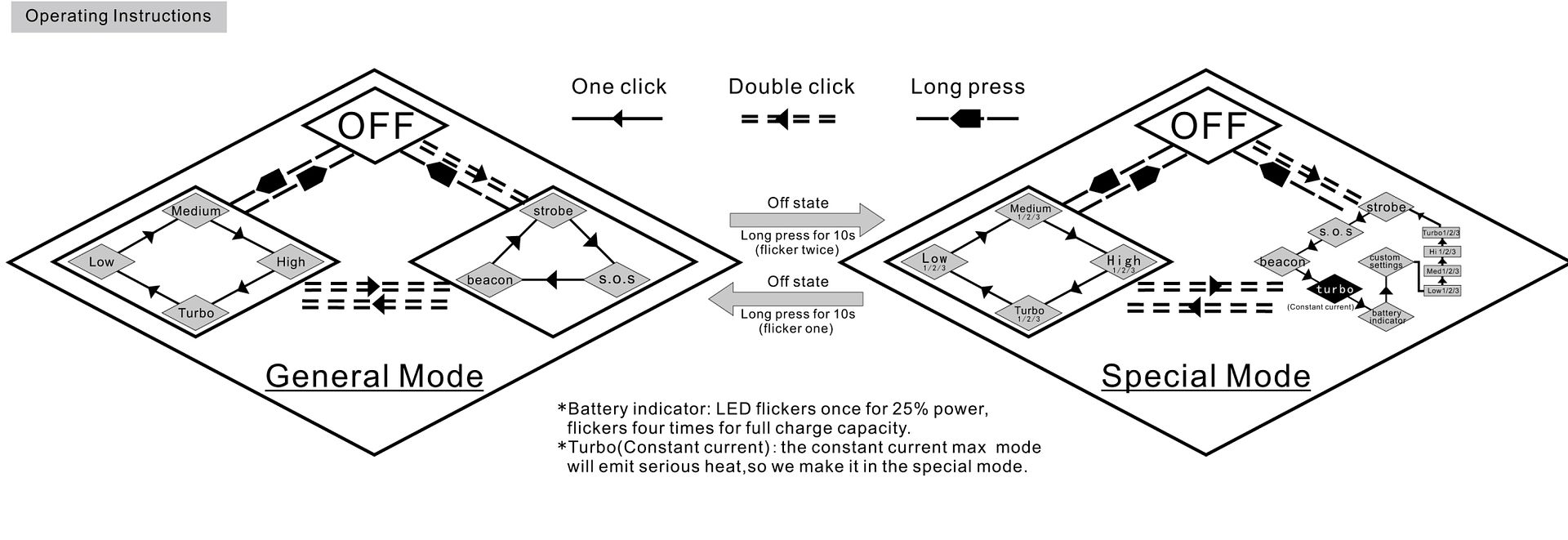
Default output levels
The manual indicates that by default, the General mode is set to L1 > M2 > H2 > T3 (i.e., the lowest low, and highest Turbo).
However, my T01 sample was inconsistent on the Hi level, and occasionally defaulted to H1 or H3 instead.
Video Overview:
For information on the light, including the build and user interface, please see my video overview:
Note that my video was taken early in testing, so I have a few more annotations than usual in the final video - I recommend you have annotations turned on with all my videos.
As an aside, if you want to get an instant notification for every new review that I post here on CPF, you can subscribe to my YouTube channel (the vids go public at the same time). Just mouse over my logo watermark on the top right-hand corner of the video for the subscribe feature to open up. You may need to tap or click, depending on the platform you are using to watch. :wave:
PWM/Strobe
The Manker T01 shows no signs of pulse width modulation (PWM) on any level. The light appears to be fully current controlled. See example M2 mode trace below, as an example.
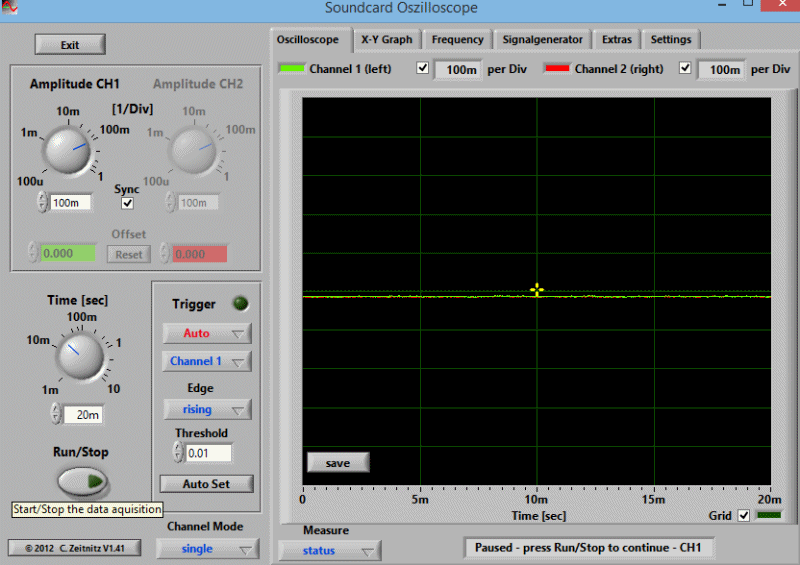
Strobe:
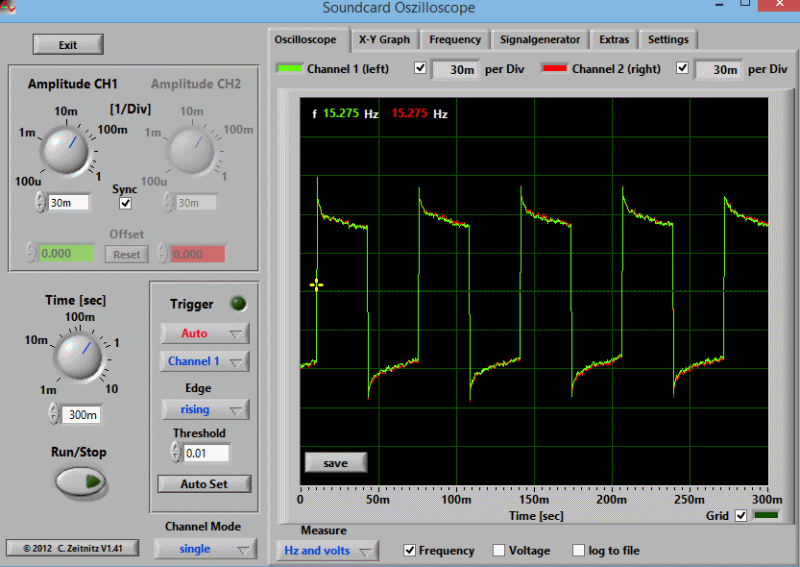
The strobe mode is a disorienting 15.3 Hz tactical strobe.
SOS:
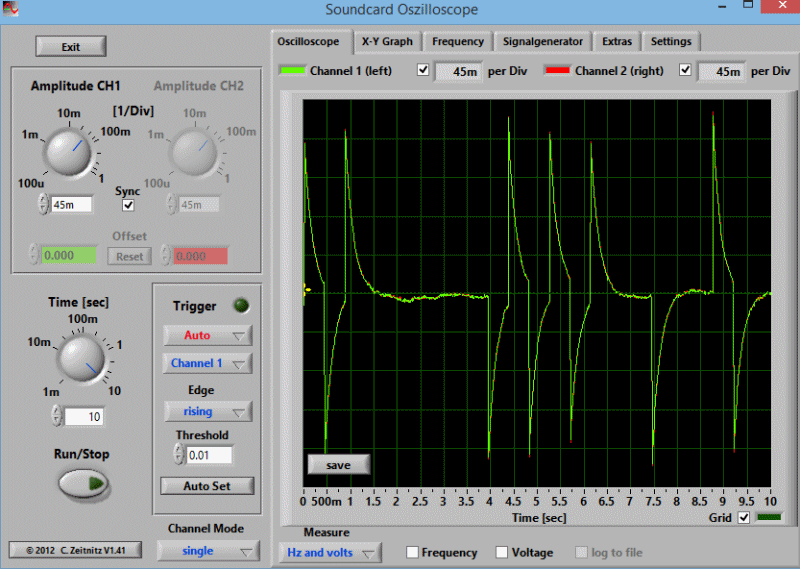
A fairly rapid SOS mode.
Beacon:
Beacon is a full power flash, once every ~1.1 seconds (~0.9 Hz)
Standby Drain
A standby current drain is inevitable on the T01, due to the electronic switch in the head. There is no difference between the General and Pro modes. Here is what I found on my sample:
5.5 uA on Eneloop Pro NiMH
18.0 uA on 14500 3.7V
Assuming a Panasonic ~2500mAh Eneloop Pro NiMH, that current would translate into over 50 years before the battery would be drained – clearly not a concern.
On 14500, the higher drain and lower capacity (750mAh) means that a standard 14500 would be drained in about 4 years and 9 months – still not much of a concern.
You can fully break this current - and physically lock-out the light - by twisting the tailcap a quarter turn.
Beamshots:
All lights are on Max output on Panasonic Eneloop Pro AA NiMH. Lights are about ~0.75 meter from a white wall (with the camera ~1.25 meters back from the wall). Automatic white balance on the camera, to minimize tint differences.
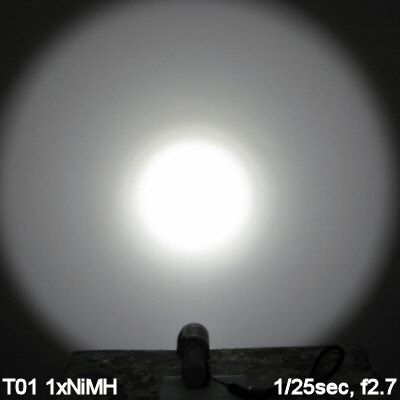
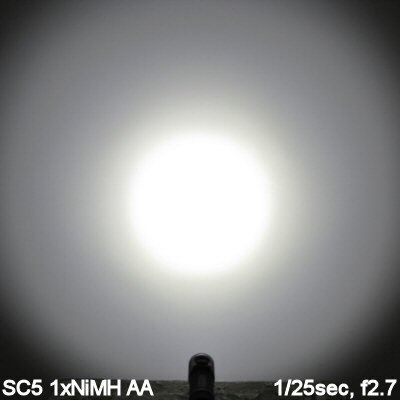
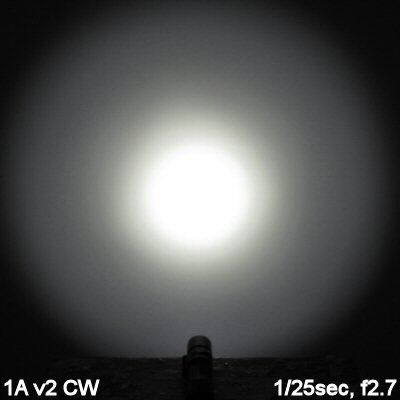
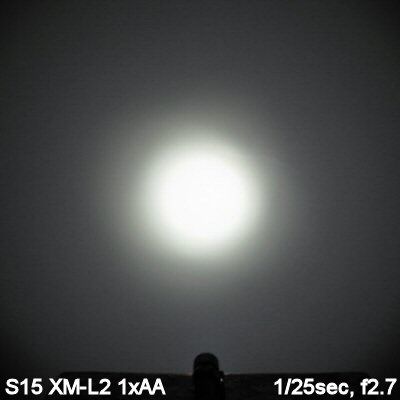
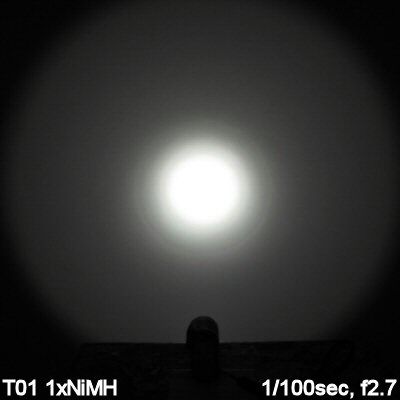
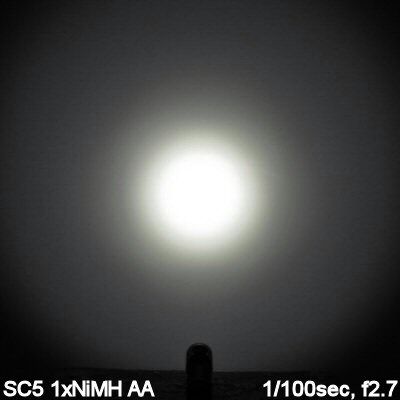
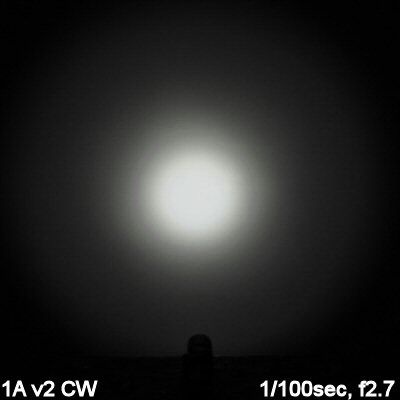
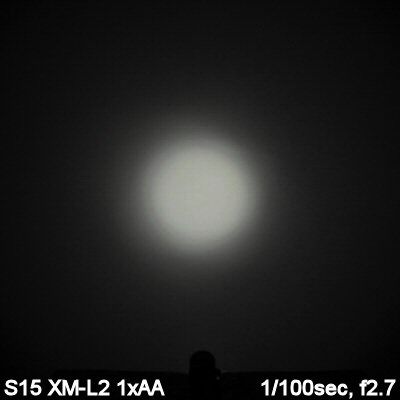
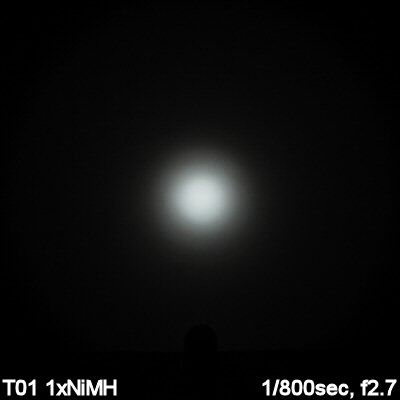
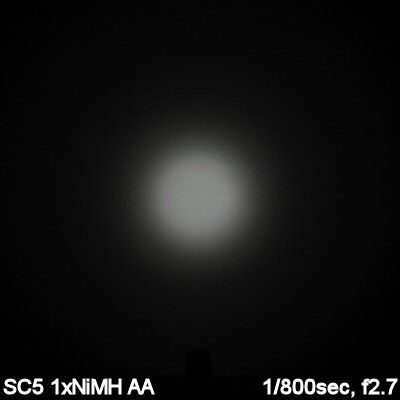
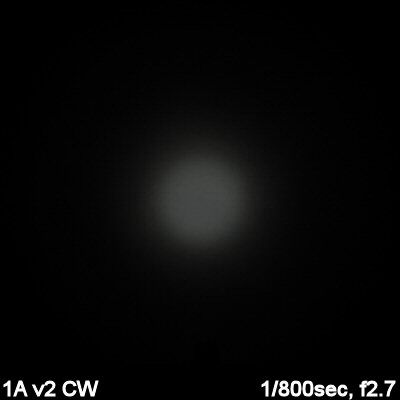
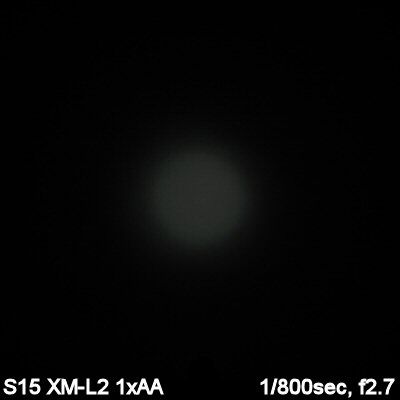
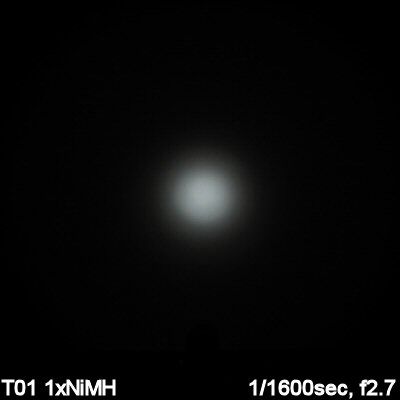
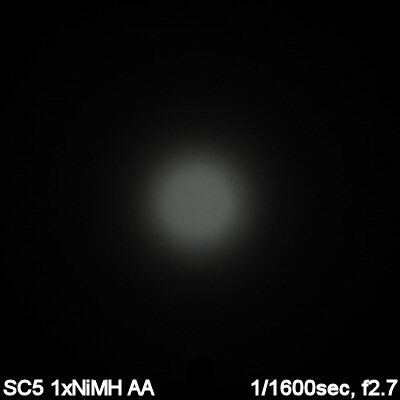
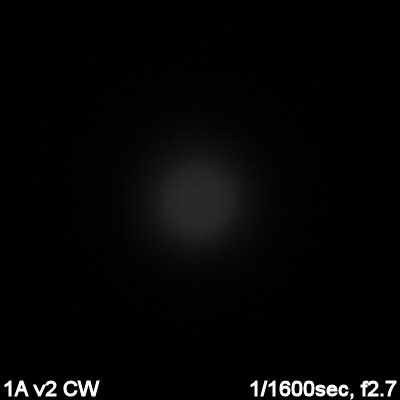

As you can see, that's an incredible amount of throw from a single 1xAA light running standard NiMH. The T01 is also very highly driven on standard AA, though not as much as the floodier Zebralight SC5.
1x14500 (AW Protected 14500) Li-ion Comparison:
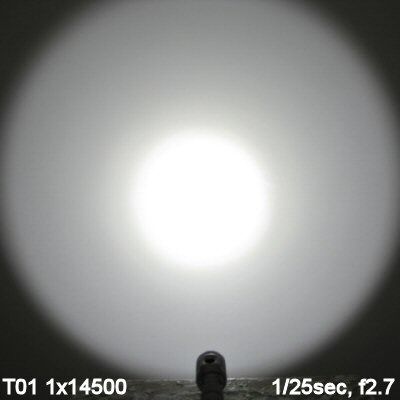
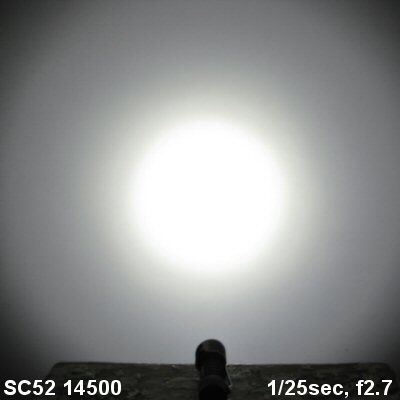
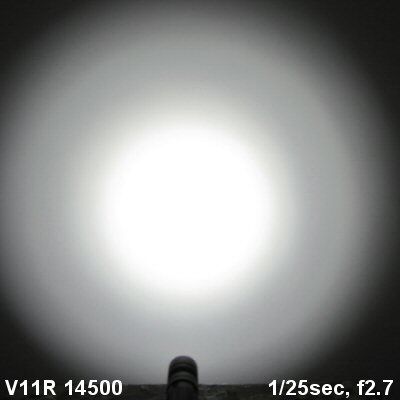
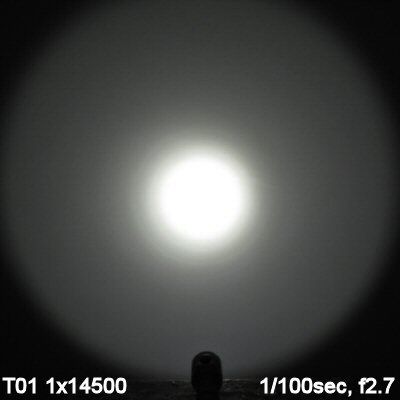
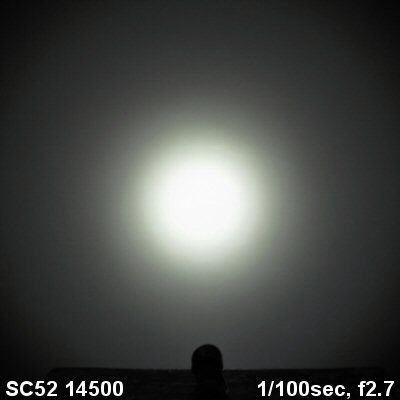
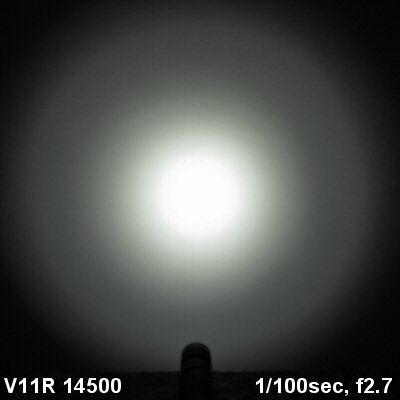
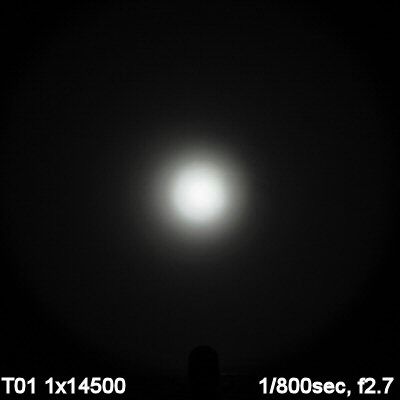
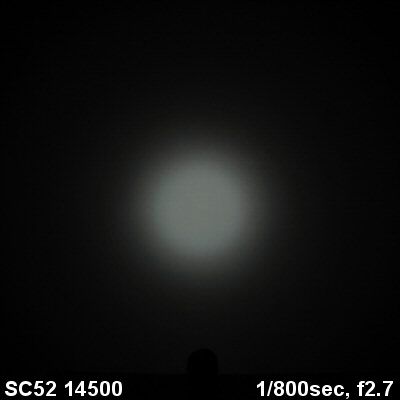
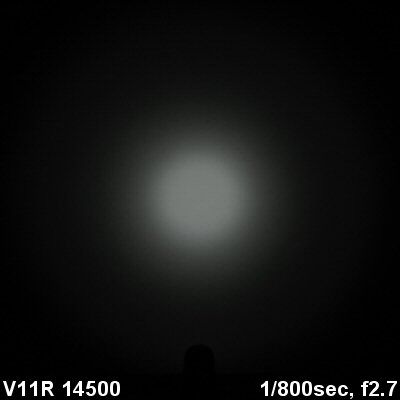
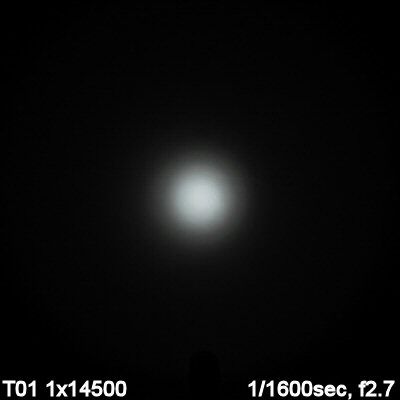
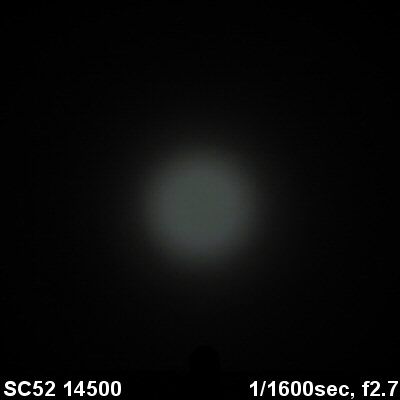
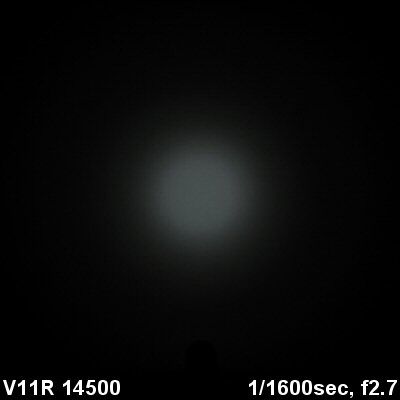
Scroll down for actual beam intensity measures.
Testing Method:
All my output numbers are relative for my home-made light box setup, as described on my flashlightreviews.ca website. You can directly compare all my relative output values from different reviews - i.e. an output value of "10" in one graph is the same as "10" in another. All runtimes are done under a cooling fan, except for any extended run Lo/Min modes (i.e. >12 hours) which are done without cooling.
I have devised a method for converting my lightbox relative output values (ROV) to estimated Lumens. See my How to convert Selfbuilt's Lightbox values to Lumens thread for more info.
Throw/Output Summary Chart:
My summary tables are reported in a manner consistent with the ANSI FL-1 standard for flashlight testing. Please see http://www.flashlightreviews.ca/FL1.htm for a discussion, and a description of all the terms used in these tables. Effective July 2012, I have updated all my Peak Intensity/Beam Distance measures with a NIST-certified Extech EA31 lightmeter (orange highlights).
Let's start with an overall comparison, including throw:
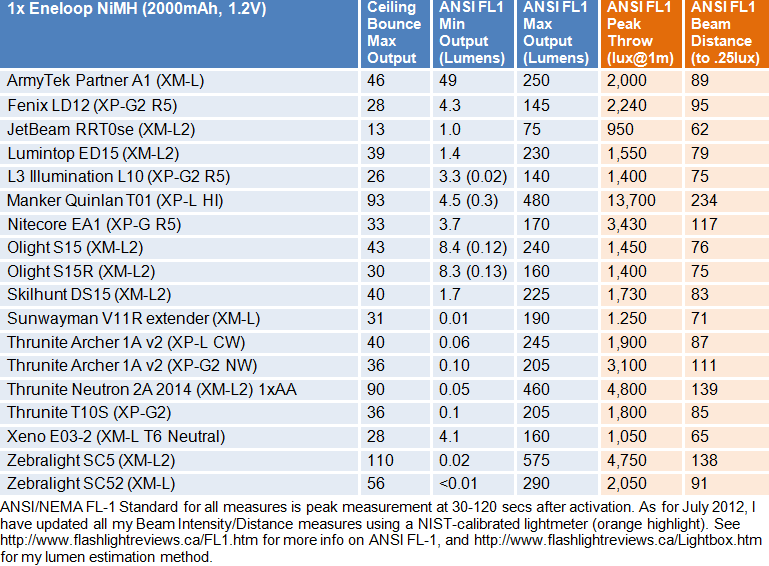
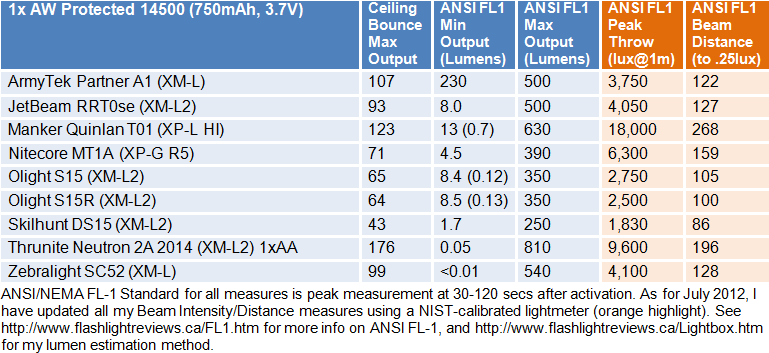
As you can see, that is a lot of throw from a single 1xAA light.
But to understand the 14500 results, keep in mind that I am using older AW protected 750mAh ICR cells.
Let's look at the relative output levels, for each sub-mode and battery type:
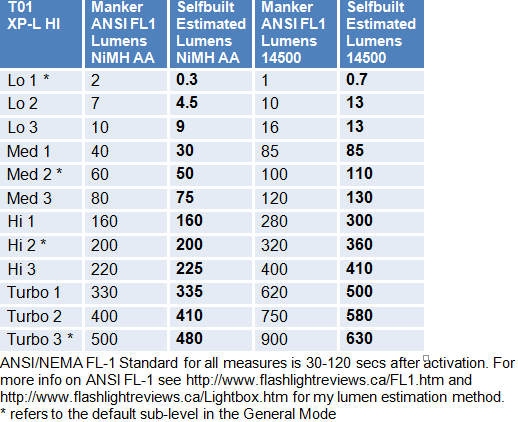
Manker's specs for standard NiMH AA match my estimated ANSI FL-1 output measures correlate remarkable well, across the board
Again, 1x14500 specs seem fairly accurate for the Lo, Med and Hi sub-levels (although L2 and L3 are exactly the same). However, the specs for the Turbo sub-levels seem to over-estimate output relative to my testing.
One possibility is that the standard AW protected 750mAh ICR 14500 batteries used in my testing may not be able to provide the maximum possible output in the T01. They are also not new, and have received a fair amount of testing use already. However, I was not able to test any of my newer protected 14500 from other makers (e.g. Olight), as I was unable to screw the cap down tightly enough to make contact on the T01. :shrug:
If you are curious, initial max output on 14500 in my lightbox was ~750 estimated lumens (although it rapidly drops off the for the ANSI FL-1 measures at 30 secs shown above). But again, you might do a bit better with newer cells. And I expect unprotected IMR cells may indeed get you closer the rated T01 specs.
As an aside, I presume the low-voltage cut-off on standard cells suggests there is an equivalent one for Li-ions as well - but I can't confirm that until I get some unprotected 14500s on hand to test.
Output/Runtime Graphs:
Note that I currently use Eneloop Pro NiMH anyway (2550mAh typical capacity) in my testing now. And all my standard runtimes are done under a cooling fan, as always.
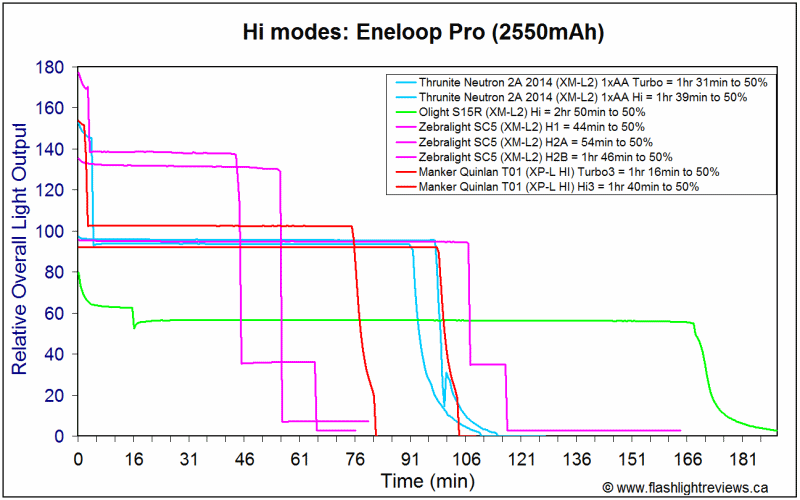
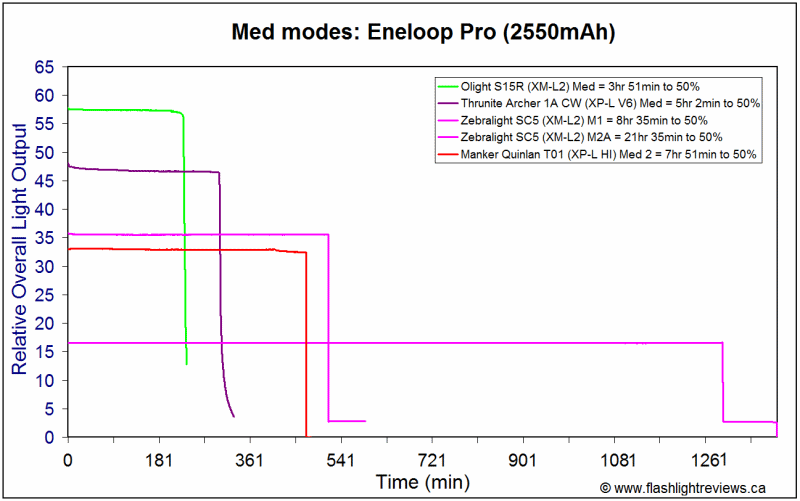
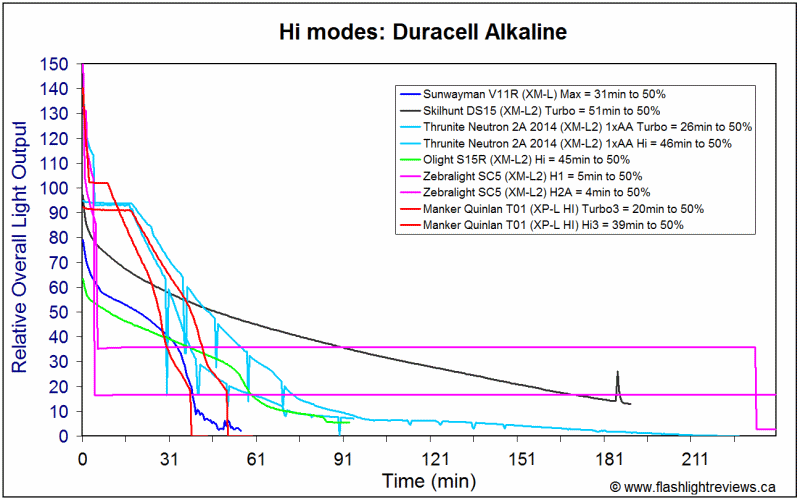
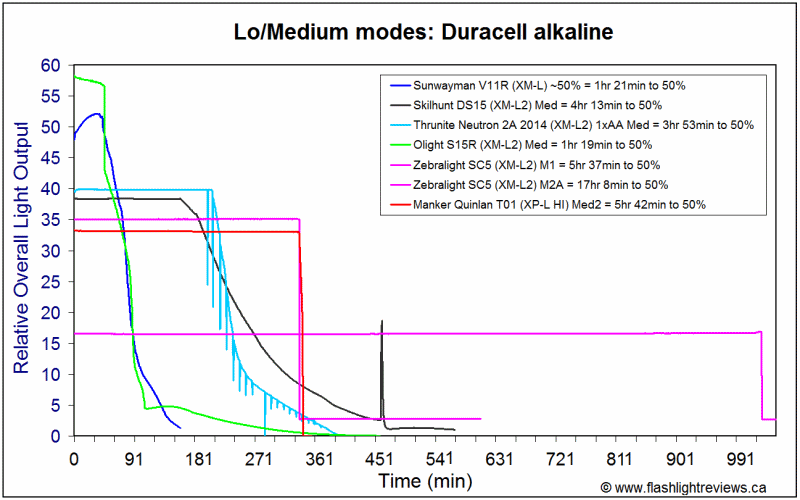
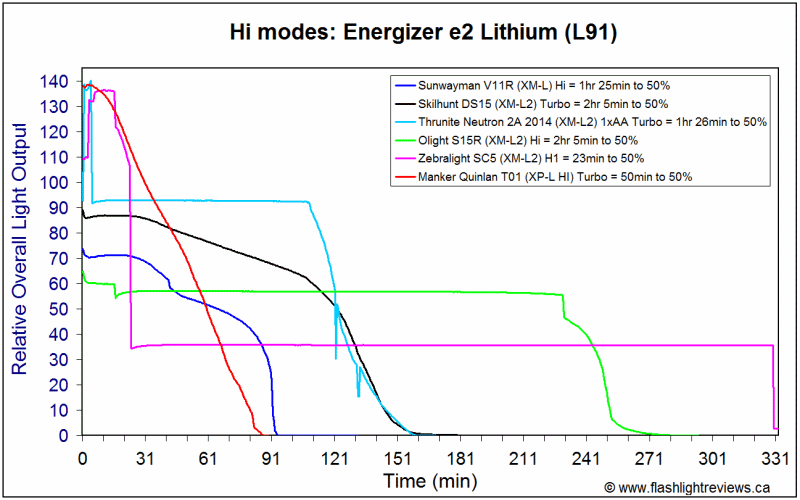
The performance of the T01 is very impressive on standard AA batteries. It performs with very flat regulation and overall efficiency comparable to the best current-controlled competition (although the Zebralight SC5 does still have a slight edge). Note the timed step-down on Turbo.
Unlike the SC5, you don't get the defined step-downs as the batteries drain here. And there seems to be a slightly early termination on the T01 (some sort of circuit cut-off perhaps?). This means you won't over-drain your NiMH – but it also means you may find yourself without light when the batteries are nearly exhausted (on both AA and NiMH).
As an aside, these results further support the T01 being current-controlled.
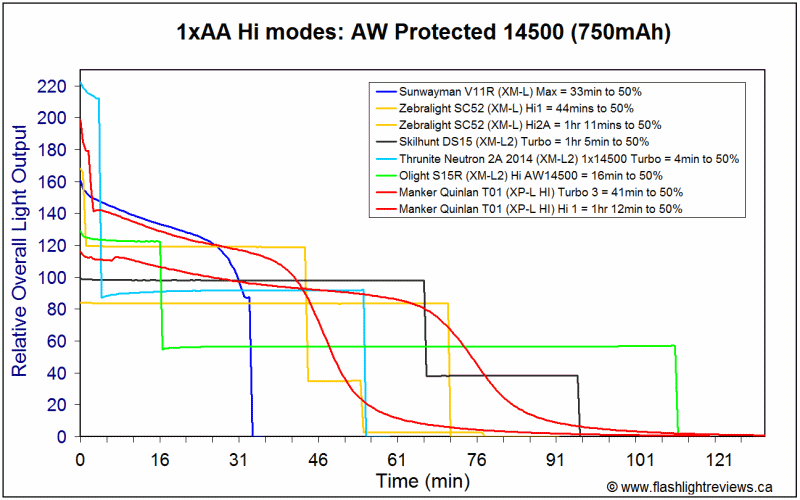
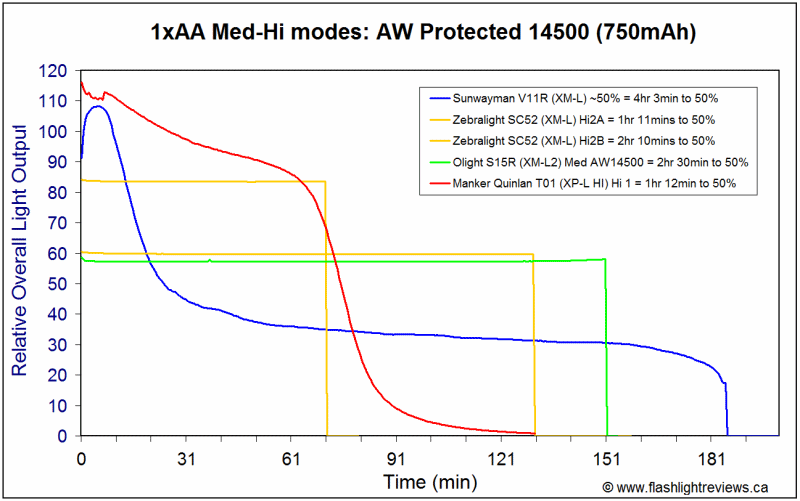
On 1x14500, you can see the T01 is struggling to maintain regulation (at least on my AW protected 750mAh ICR batteries). For the most-part, this regulation pattern is pretty close to direct-drive. That said, overall efficiency is still top-notch. But since max output is not that much higher (at least on my AW protected ICR batteries), you are really best sticking with NiMH AA for maximum runtime and flat regulation on the T01.
Again, unprotected IMR 14500 may get you a higher initial output, and improved regulation.
Potential Issues
Due to the very throwy nature of the light, you can expect some artifacts in the beam hotspot – although these are only really noticeable on smooth surfaces.
Given the heavily-driven nature on the highest levels, stick with good quality NiMH. Alkaline batteries will not perform well at all on these levels.
Body tube is a little short, and not all protected 14500 cells will fit and work in the light. Only my AW protected 750mAh cells would work (and even then, a fair amount of force was required).
The T01 output specs are remarkably accurate – except for the Turbo sub-levels on 1x14500. However, that may be due in part to the older AW 750mAh protected ICR cells that I am using in my testing. Newer cells – especially unprotected IMR – should be capable of somewhat higher sustained output.
The default sub-level settings of the T01 in General mode are good – although I found the Hi level would sometimes activate in Hi1 or Hi3 (and not consistently in Hi2, as expected).
The sub-level programming of the Pro Mode is a little unusual, and requires you to reset each output level in sequence (from the Lo to Turbo). While you will need the manual initially to program, it is straight-forward and easy to do on the fly, once you get used it.
Due to the electronic switch, there is a minimal stand-by current - but it is so low as to be completely negligible in practice. You can always lock out the light at the tailcap to prevent accidental activation.
Preliminary Observations
The T01 is very impressive offering from a new manufacturer. It has outstanding throw, output and runtime performance, and support for both standard AA and 14500 Li-ion.
Manker has certainly spent some time getting a good circuit put together, as you can see by the lack of PWM, excellent efficiency, flat regulation (on standard AA), and good range of output levels. The AA specs are bang-on here, and there are no issues with the performance of the light. The programming interface may not be the most intuitive, but it works well once you get used to it (and is easy to use in both General Mode and Pro Mode).
Performance on 14500 is very good for this battery class, but there are some issues. Foremost is the difficulty in getting modern protected 14500 batteries to fit in the light – it takes a lot of force to screw down the tailcap, and I was unable to get some brands to work (due to length). Also, the light is largely direct-drive on 14500 (at least on the higher levels tested here). Turbo output was lower in my testing than the specs indicate, but that may have to do with the age of the cells I had on hand (i.e., none of my newer 14500s would fit).
I would expect unprotected IMR 14500 to have greater sustained output on Turbo. I plan to order some of these on my next battery batch purchase, but it will likely be a few months before I can update this review. In any case, 14500 has much lower work capacity than modern NiMH - and so would underperform in runtime at lower levels. Unless you really need the extra turbo output, I recommend you stick with quality NiMH AA.
Beam pattern is incredibly throwy for a light this size – this is a real pocket rocket.
If you want to impress people with how far a 1xAA can throw, this is the light for you.
P.S.: I will update this review once I get some IMR 14500 cells in to test. :wave:
----
T01 was supplied by Manker for review.
Last edited:



